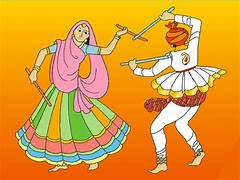Information about Garba
Garba is a traditional folk dance form that originates from the Indian state of Gujarat but is now popular and celebrated across India and the world. It is an integral part of the Navaratri festival, which spans nine nights and is dedicated to the worship of the Hindu Goddess Durga. Garba is performed with great enthusiasm during this festival and holds cultural and social significance.
 |
| Garba Dance |
Here is some
information about Garba:
1.
Origin and History: Garba has ancient roots and is
believed to have originated from the state of Gujarat, where it has been a
cherished tradition for centuries. It is associated with the worship of the
goddess Durga and is performed to celebrate her divine feminine energy.
2.
Dance Style: Garba is characterized by its
circular formation, where dancers move in a circle around a centrally lit lamp
or image of the goddess. The circular movement symbolizes the cycle of life,
birth, and death, as well as the continuity of the universe.
3.
Music and Instruments: Garba is
accompanied by lively and rhythmic music. The primary musical instruments used
include dhol (a double-headed drum), dholak (a smaller hand-played drum), and
various traditional string and wind instruments. The songs, known as
"Garbas" or "Raas," are typically sung in Gujarati and
celebrate the divine and cultural themes.
4.
Costumes: Dancers wear colorful and
traditional attire, with women typically donning chaniya cholis (long skirts
and blouses) and men wearing kurtas and turbans or kedias (traditional Gujarati
attire).
5.
Dance Movements: Garba dance involves intricate
footwork and hand movements. Dancers clap their hands, strike sticks together
(a style known as "Dandiya Raas"), and perform various graceful
gestures while maintaining the circular formation.
6.
Social and Cultural Significance:
Garba is not only a religious dance but also a social and cultural event. It
provides an opportunity for people to come together, celebrate their culture,
and strengthen community bonds. It promotes a sense of unity and festivity.
7.
Modern Celebrations: Garba has evolved over the years,
and modern variations incorporate elements of fusion and contemporary music. It
is no longer limited to Gujarat but has become a global phenomenon, with Garba
events held in many countries.
8.
Navaratri Festival: Garba is most prominently performed
during the Navaratri festival, especially during the first nine nights, known
as "Navaratri Raas." Each night is dedicated to one of the Nine forms
of the goddess Durga, and Garba is performed in her honor.
Over all, Garba is a vibrant and culturally rich dance form that celebrates
tradition, spirituality, and community. It is an essential part of the
Navaratri festival and continues to thrive as a symbol of cultural identity and
joyous celebration.








0 Comments